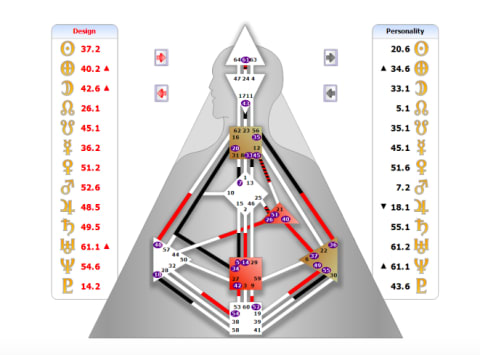These descriptors feel like little badges of honor. They may not change the way I present myself in the world, but they provide a framework for analyzing some of my patterns and tendencies. To calculate your human design (you can find out yours using an online calculator, like this one), you’ll need your birth date, time, and location. The resulting chart is a slightly intimidating map of numbers and symbols arranged on a human figure. It’s split into two sides: personality, the behaviors you probably identify with, and design, your subconscious tendencies. It’s no surprise that human design is starting to appeal to the corporate sector. It doesn’t feel as esoteric as other readings, and it lends itself to personalized productivity tips. “What I’ve found working with companies is people are beyond ready for this,” says Claire, who counts the CEOs of Monday and HER USA as her clients. In the two months since my reading, I’ve definitely found myself knocking off my to-do list faster and being more intentional about what makes it on there in the first place. In my reading, I learned that I’m a manifesting generator, a type of builder who has a knack for bringing things into being quickly and efficiently. “You wake up each morning with a motor, and your job is to use that energy in super-satisfying ways so you can go to bed and wake up recharged,” Claire told me. While this information wasn’t necessarily earth-shattering, hearing it said aloud reinforced what I instinctively knew to be true but wasn’t acting on: I need to slow down, not say yes to things so easily, and conserve my energy for projects I’m really excited about. In the workplace, I need to multitask less and allow myself to explore different viewpoints more. The session ended with some questions to ask myself from time to time, which I’ve found helpful in staying on track: How does it feel to let go of my need to respond right away? Where do you notice yourself feeling frustrated throughout the day? “You are meant to be lit up by what you’re working on—that’s how you can inspire others,” Claire said to end the reading. It may not be the most original advice ever, but it’s certainly something to work toward. Emma received her B.A. in Environmental Science & Policy with a specialty in environmental communications from Duke University. In addition to penning over 1,000 mbg articles on topics from the water crisis in California to the rise of urban beekeeping, her work has appeared on Grist, Bloomberg News, Bustle, and Forbes. She’s spoken about the intersection of self-care and sustainability on podcasts and live events alongside environmental thought leaders like Marci Zaroff, Gay Browne, and Summer Rayne Oakes.





